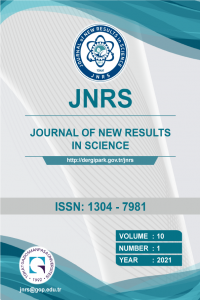Investigation of Crimean Congo Hemorrhagic Fever Virus in Ticks (Acari: Ixodidae) Infesting on Hedgehogs in Turkey
– Southern white-breasted hedgehogs, Erinaceus concolor, are synanthropic and very common wild mammals sharing the same habitats with humans, especially in rural areas. Hedgehogs may be infested by ticks and contribute to circulation of various tick-borne disease agents. In the present study, we investigated ixodid ticks infesting on hedgehogs killed by cars on the highways in the Tokat province for the presence of Crimean Congo hemorrhagic fever virus (CCHFV) using real-time RT-PCR. A total of 54 ixodid ticks were collected from 52 hedgehogs and they were identified as Hyalomma aegyptium (9.26%), Hyalomma marginatum (9.26%), Hyalomma scupence (3.7%) and Rhipicephalus turanicus (77.8%), using morphological keys. According to realtime RT-PCR tests, CCHFV was detected in one of five H. aegyptium samples. The results shown that H. aegyptium may be contribute transmission of the CCHFV to humans in the urban areas. In addition, CCHFV in the H. aegyptium were documented for the first time in this study
Keywords:
-,
___
- Ozen, A.S., 2006. Some Biological, Ecological and Behavioral Features of Erinaceus concolor Martin, 1838 (Mammalia: Insectivora) in Turkey. G.U. Journal of Science. 19(2):91-97.
- Skuballa, J., Oehme, R., Hartelt, K., Petney, T., Bücher, T., Kimmig, P., Taraschewski, H., 2007. European hedgehogs as hosts for Borrelia spp., Germany. Emerg. Infect. Dis. 13:952– 953.
- Skuballa, J., Petney, T., Pfäffle, M., Taraschewski, H., 2010. Molecular detection of Anaplasma phagocytophilum in the European hedgehog (Erinaceus europaeus) and its ticks. Vector-Borne Zoon. Dis. 10:1055–1057.
- Riley, P.Y., Chomel, B.B., 2005. Hedgehog zoonoses. Emerg. Infect. Dis. 11, 1–5.
- Kozuch, O., Nosek, J., Ernek, E., Lichard, M., Albrecht, P., 1963. Persistence of tickborne encephalitis virus in hibernating hedgehogs and dormice. Acta Virol. 7:430–433.
- Causey, O.R., Kemp, G.E., Madbouly, M.H., David-West. T.S.. 1970. Congo virus from domestic livestock, African hedgehog, and arthropods in Nigeria. Am J Trop Med Hyg. 19(5):846–850.
- Karaer, F., M. Kilinc, and H. Kutbay. 1999. The Woody Vegetation of the Kelkit Valley. Turk. J. Bot. 23:319-344.
- Bursali, A., Tekin, S., Orhan, M., Keskin, A., Ozkan, M., 2010. Ixodid ticks (Acari: Ixodidae) infesting humans in Tokat Province of Turkey: species diversity and seasonal activity. Journal of Vector Ecology 35 (1): 180-186.
- Filippova, N.A., 1977. Ixodid ticks (Ixodinae). Fauna USSR New Ser. 4 (4). Nauka, Moscow, Leningrad, 316 pp.
- Estrada-Peña, A., Bouattour, A., Camicas, J.L., Walker, A.R., 2004. Ticks of Veterinary and Medical Importance: The Mediterranean Basin. A Guide of Identification of Species. University of Zaragoza Press, Zaragoza, p. 131.
- Kolonin, G. V. 2009. Fauna of ixodid ticks of the world (Acari: Ixodidae). http://www.kolonin.org/18_1.html. Accessed 12 December 2012.
- Albayrak H., Ozan, E., Kurt, M., 2010. Molecular detection of Crimean- Congo hemorrhagic fever virus (CCHFV) but not West Nile Virus (WNV) in hard ticks from provinces in Northern Turkey. Zoonoses Public Health 57:156–160.
- Aktas M., Altay K., Dumanli N., 2006. A molecular survey of bovine Theileria parasites among apparently healthy cattle and with a note on the distribution of ticks in eastern Turkey. Vet Parasitol. 138(3-4):179-185.
- Apanaskevich, D.A., Filippova, N.A., Horak, I.G., 2010. The genus Hyalomma Koch, 1844. x. redescription of all parasitic stages of H. (Euhyalomma) scupense Schulze, 1919 (= H. detritum Schulze) (Acari: Ixodidae) and notes on its biology. Folia Parasitol. 57(1): 69-78.
- Koprulu, T.K., Tekin, S., Keskin, A., Bursali, A., 2012. Prevalence of Rickettsia species in Hyalomma marginatum ticks collected from humans in Tokat Province in Turkey. 15. European Congress on Biotechnology Congress "bio-crossroads", N. Biotechnol. 29: S167.
- Gargili A., Palomar A.M., Midilli K., Portillo A., Kar S., Oteo, J.A., 2012. Rickettsia species in ticks removed from humans in Istanbul, Turkey. Vector-Borne and Zoonotic Dis. 12(11), 938-941.
- Hoogstraal, H., Kaiser, M.N., 1960. Some host relationships of the Tortoise tick, Hyalomma (Hyalommasta) aegyptium (L.) (Ixodoidea: Ixodidae) in Turkey. Ann Entomol Soc Am 53(4):457-458.
- Široký, P., Mikulíček, P., Jandzík, D., Kami, H., et al., 2009. Co-distribution pattern of a haemogregarine Hemolivia mauritanica (Apicomplexa: Haemogregarinidae) and its vector Hyalomma aegyptium (Metastigmata: Ixodidae). J Parasitol. 95(3):728-733.
- Bursali, A., Tekin, S., Keskin, A., Ekici, M., Dundar, E., 2011. Species diversity of ixodid ticks feeding on humans in Amasya, Turkey: seasonal abundance and presence of Crimean- Congo hemorrhagic fever virus. J Med Entomol 48(1):85–93.
- Vatansever, Z., Gargili, A., Aysul, N.S., Sengoz, G., Estrada-Peña, A., 2008 Ticks biting humans in the urban area of Istanbul. Parasitol Res 102:551–553
- Tavassoli, E.,Rahimi-Asiabi, N.,Tavassoli, M., 2007. Hyalomma aegyptium on Spur-thighed Tortoise (Testudo graeca) in Urmia Region West Azerbaijan, Iran. Iranian J Parasitol. 2(2):40-47.
- Gazyagci, S., Asan, N., Demirbas, Y., 2010. A common tortoise tick, Hyalomma aegyptium Linne 1758 (Acari: Ixodidae), identified on eastern hedgehog (Erinaceus concolor Martin 1838) in Central Anatolia. Turk. J. Vet. Anim. Sci. 34(2): 211-21.
- Guner, A.S., Hashimoto, N., Kadosaka, T., Imai, Y., Masuzawa, T., 2003. A novel, fast- growing Borrelia sp. isolated from the hard tick Hyalomma aegyptium in Turkey. J Clin Microbiol 149: 2539–2544.
- Bitam, I., Kernif, T., Harrat, Z., Parola, P., Raoult, D., 2009. First detection of Rickettsia aeschlimannii in Hyalomma aegyptium from Algeria. Clin Microbiol Infect. 15 (Suppl 2): 253-254.
- Široký, P., Kubelová, M., Modrý, D., Erhart, J., Literák, I., Špitalská, E., Kocianová, E., 2010 Tortoise tick Hyalomma aegyptium as long term carrier of Q fever agent Coxiella burnetii–evidence from experimental infection. Parasitol Res 107:1515–1520.
- Silaghi, C., Skuballa, J., Thiel, C., Pfister, K., Petney, T., Pfäffle, M., Taraschewski, H., Passos, L.M., 2012. The European hedgehog (Erinaceus europaeus) - a suitable reservoir for variants of Anaplasma phagocytophilum?. Ticks Tick Borne Dis. 3(1):49-54.
- ISSN: 1304-7981
- Yayın Aralığı: 3
- Başlangıç: 2012
- Yayıncı: TOKAT GAZİOSMANPAŞA ÜNİVERSİTESİ
